DOI:10.32604/cmc.2022.030115

| Computers, Materials & Continua DOI:10.32604/cmc.2022.030115 |  |
| Article |
Agricultural Supply Chain Risks Evaluation with Spherical Fuzzy Analytic Hierarchy Process
Faculty of Business, FPT University, Hanoi, 100000, Vietnam
*Corresponding Author: Phi-Hung Nguyen. Email: hungnp30@fe.edu.vn
Received: 18 March 2022; Accepted: 10 May 2022
Abstract: The outbreak of the COVID-19 pandemic has impacted the development of the global economy. As most developing and third world countries are heavily dependent on agriculture and agricultural imports, the agricultural supply chains (ASC) in all these countries are exposed to unprecedented risks following COVID-19. Therefore, it is vital to investigate the impact of risks and create resilient ASC organizations. In this study, critical risks associated with ASC were assessed using a novel Analytical Hierarchy Process based on spherical fuzzy sets (SF-AHP). The findings indicated that depending on the scope and scale of the organization, supply risks, demand risks, financial risks, logistics and infrastructure risks, management and operational risks, policy and regulatory risks, and biological and environmental risks all have a significant impact on ASC. This research highlighted that the most significant criterion is specified as Transportation (TP), followed by Market (MA) and Policy (PO), respectively. Meanwhile, Technology (TL) is the least significant criterion. The study’s findings can help managers with a holistic view of the agriculture supply chain risk mitigation. Furthermore, this study may assist managers in sharing information about the processing of agricultural products from top to bottom to manage risk in the supply chain.
Keywords: MCDM; supply chain risks; spherical fuzzy; AHP; Vietnam
COVID-19 pandemic has caused unprecedented challenges to all sectors around the globe, particularly the agriculture supply chain. Its spread has led to numerous supply chain problems throughout the world [1]. The pandemic prevents people from working and socializing, particularly in the services and agriculture sectors [2]. It exposes agricultural supply chains (ASC) to new dangers, especially the developing and third-world nations that rely significantly on agriculture and agricultural imports. Food supply and demand are inextricably linked to food security; as a result, global food security is jeopardized [3]. The supply chain refers to the flow and transportation of goods from manufacturers to final consumers. The ASC includes manufacturers, processors, distributors, wholesalers, retailers, logistics providers, and buyers (Fig. 1). There are two types of ASC systems to consider fresh agricultural products such as vegetables. Processed food comprises products such as snacks, juices and canned products. Fresh agricultural products have a short shelf life, whereas processed meals can be stored for longer [4]. Vietnam’s agricultural supply chain serves as a link between rural and urban areas and assists in the urbanization process by connecting regions [5].
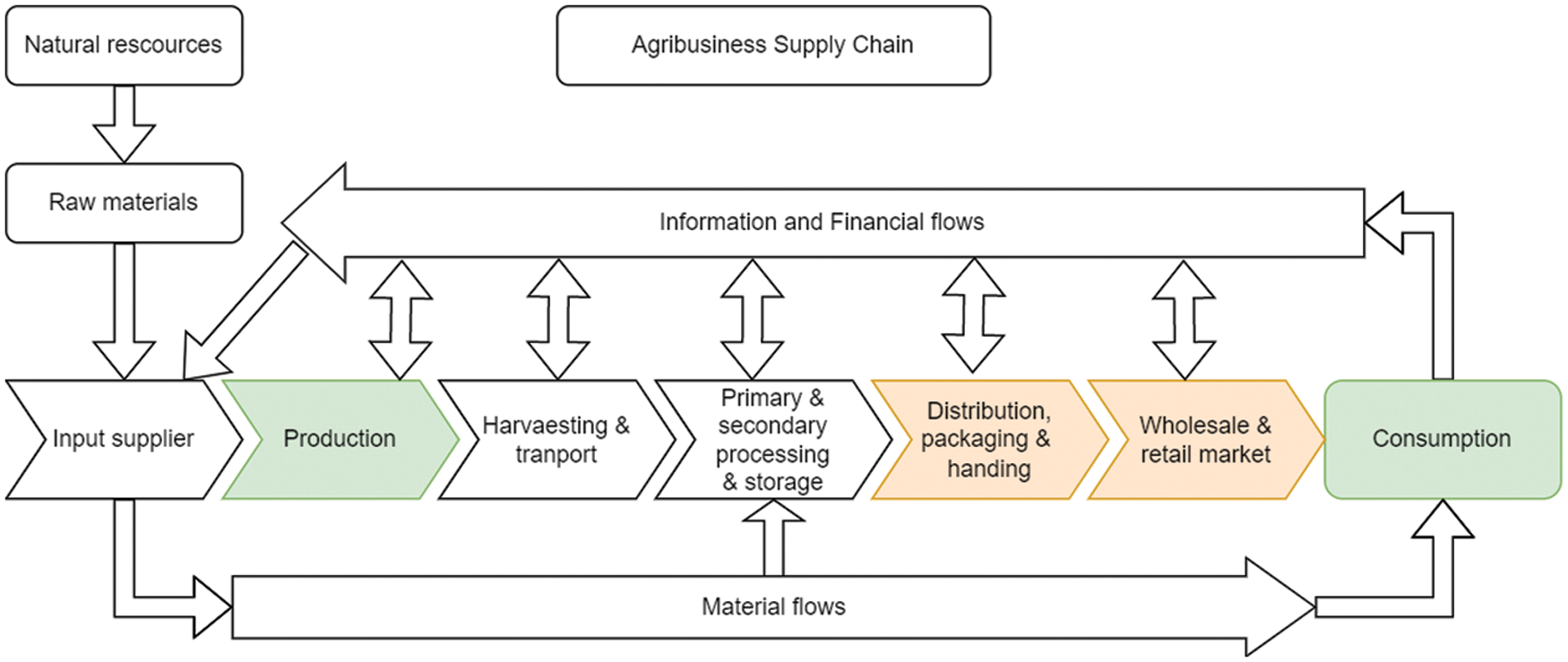
Figure 1: Flowchart of agribusiness supply chain
Nowadays, the ASC is one of the wide topics investigated in various previous research [6]. Supply chain management in the context of the agriculture sector is influenced by various variables and aspects, including supply-demand, policies, planning and purchasing activities, and transportation. This study analyzed the importance of numerous factors affecting ASC using data from a real-world examination. The proposed indicators were reviewed prior to evaluating component-related risks on ASC. Only a few studies have examined this portion of the literature and concentrated on the COVID-19-induced hazards to ASCs, emphasizing the qualitative aspects of risk management rather than quantifying the current consequences on the enterprises functioning in the ASC [1]. Due to the assessment’s multi-criteria framework, which incorporates many criteria from several domains, Multiple Criteria Decision-Making (MCDM) is a superior technique for analyzing and prioritizing a subject. In the context of Vietnamese ASC, a literature-based approach provides a limited view of the essential risks. The critical risks under COVID-19 impacts adopted in this study obtain the necessary information through the existing literature. Further, ten experts’ opinions are incorporated to consolidate critical risks affecting the ASC in Vietnam. Accordingly, the primary objectives are presented as follows: (1) Determining the critical risks related to ASC in Vietnam under COVID-19 impacts; (2) Analyzing consolidated risks of the ASC in Vietnam under COVID-19 impacts using the SF-AHP approach.
This study is first to propose the SF-AHP method to identify critical risks associated with agriculture supply chains to obtain the mentioned targets. After determining independent factors based on existing literature, and experts’ comments, the SF-AHP technique is applied to quantify the decision-makers linguistic preferences of proposed factors and identify the weights.
The rest of this study is organized as follows: Section 2 presents the literature review on ASC and related works’ methodologies, followed by presenting the proposed research framework in Section 3. Section 4 reports the case study results and discussions, while Section 5 provides conclusions and future works.
Agriculture is the most comprehensive phrase used to describe how plants and animals provide food and other products to the global population. Various terminologies are used to describe different types of agricultural production: horticulture and animal husbandry. Horticulture is a pioneer in crop production, food supply, and crop yield optimization. In addition, animal husbandry is defined by cattle breeding, breeding, raising, and constructing livestock barns [7]. For economic growth and development, distribution competitiveness in a physical exchange with the entire world is now critical. The supply chain encompasses not just the producer and its suppliers but also transporters, warehouses, retailers, and consumers. New product creation, marketing, operations, distribution, finance, and customer support are just a few examples [8]. Hobbs [9] indicated that the supply and demand shocks affected the food manufacturing sector due to the steep fall in demand for processed foods caused by border closures and trade restrictions. Torero [10] emphasizes the influence of COVID-19 on the storage and transportation phases, which would raise procurement prices and result in ASC delays. Barichello [2] showed that new transportation rules have resulted in trucks waiting at crossings, harming the fruit and vegetable sector, causing congestion, and slowing all trade. Moreover, Khan [11] presented the theoretical framework on the agricultural supply chain factors with all procedures that link farm output to the final consumer. Farnsworth et al. [12] found that the policies encompass paid leave provisions for critical personnel, workplace safety precautions, and travel restrictions imposed due to the COVID-19 outbreak. Haley et al. [13] investigated the multiple hazards experienced by migrant workers working in ASCs and offered preventative measures to reduce occupational health and safety problems. Further, Larue et al. [14] found that rising unemployment, school closings, and social isolation diminish demand for some foods while increasing desire for others, resulting in shifts in investment demand, including labor.
2.2 Literature Review on ASC Risks
Based on the current literature review of the pertinent literature on ASCs, the prominent ASC risks are documented in this section. Various prior studies identified a variety of hazards associated with the agricultural supply chain, including weather, demand, logistics and infrastructure, political and policy risks, financial risks, biological, market, and environmental risks [15,16]. Such risk sources can interrupt organizational operations, resulting in the firm’s poor performance. It can be inferred that the ASC risks vary differently across the ASC phases. In this study, the author proposes a set of risks related to ASC under COVID-19 impacts in the context of Vietnam based on experts’ opinions as follows:
Market-related risks (MA): The market consists of supply-demand forces. Supply-related risks refer to the uncertainty connected with the acquisition of materials and associated operations, such as supplier failure and raw material integrity. Moreover, demand-related risks are associated with the fluctuating demand for agriculture products and the market’s volatility. The primary hazards in this category are those associated with consumers and their attitude toward the products [1].
Government’s policy risks (PL): Government’s policy refers to changes in government policies, insecurity about fiscal and tax policies, insecurity regarding financial stability, banking system policy, insecurity regarding trade and market policies, and governance insecurity, as well as government interventions toward COVID-19 [9].
Finance-related risks (FN): Financial risks relate to lack of financial support, delays in accessing financial support, and the uncertainty of credit support. Force majeure situations such as the COVID-19 pandemic might interrupt previously established supply chain procedures. This disruption can directly impact the financial performance of supply chain companies [17]. Customer services are affected by the covid-19 pandemic, which impacts selling costs, such as purchasing costs, production costs, depreciation costs and expenses, distribution costs, and inventory-related costs, such as interest [7].
Operation-related risks (OR): It describes the company’s reduced capacity to manufacture and sell goods and services as a result of a breakdown in operational and production capabilities [18]. Many manufacturers were forced to shut down their operations completely, while others had to cut output to bare minimums. Stakeholders in the agricultural supply chains on the processing, retail, and distribution sides have suffered greatly due to demand-side shocks (panic purchasing, stockpiling), supply shortages, and transportation difficulties [19].
Technology risks (TN): Technology is divided into two segments: focusing on machines to optimize productivity or building software to improve competitiveness in the supply chain to improve service levels, reduce lower inventory, risks and supply chain costs. The newly applied technology is the solution for the agricultural supply chain, ensuring that the orders are shipped as planned [20].
Labor-related risks (LB): Lockdown significantly impacts the supply chain when employees are away from work due to COVID-19 inflection or restrictions on local and migrant employees’ movement [16]. Furthermore, a shortage of farmworkers was a severe issue. The crisis lowers the capacity of enterprises and agribusiness to work due to a lack of human resources, and physical distance must be maintained during production.
Transportation risks (TR): The goods will not be delivered to the consumer on time or in acceptable condition if they do not have the required conveyance. Because of its short shelf life, high perishability, regulated temperature needs, and delivery issues are especially critical for perishable agriculture like fruit and vegetables due to a lack of adequate transportation techniques, high transportation expenses, a lack of temperature-controlled trucks to transport goods, high road and bridge expenditures, and other factors [21].
MCDM is gaining traction as a viable tool for assessing complex real-time problems in agriculture supply chain management decision-making. Existing literature suggests the widely-used applications of MCDM based on two kinds of models, including knowledge-based approaches and data-driven strategies [1]. Yazdani et al. [22] proposed an Evaluation of Data based on the average ASsessment (EDAS) method to rank different agricultural projects that pretend to mitigate the flood risks and their impacts on crop areas. Akbari et al. [23] prioritized policies and strategies for climate-related desertification risk using the PROMETHEE method in Iran. Gardas et al. [24] applied the decision-making and trial evaluation laboratory (DEMATEL) method to identify and model the critical causal factors of post-harvest losses (PHL) in the fruit and vegetable (F&V) supply chain in India. As with the current problem, a fuzzy extension of decision-making approaches is beneficial when confronted with challenges, including vagueness and fuzziness. A fuzzy extension of the MCDM is well-suited for such a challenge of decision-making [25]. Kumar et al. [16] discussed the uncertainties and risks related to the COVID-19 pandemic in the food supply chain using the fuzzy extension to the best worst method (BWM). Recently, Sharma et al. [1] investigated ASC risks by disruptions using the Fuzzy linguistic Quantifier Order Weighted Aggregation (FLQ-OWA) method.
The spherical fuzzy number (SFNs) is employed; it is a new development of fuzzy sets Kutlu Gündouğdu and Kahraman [26] due to its conceptual simplicity and computational simplicity. Although various research has been conducted to investigate the elements that influence ASC, little research on the risk associated with the COVID-19 effect was conducted simultaneously. In the context of ASC in Vietnam, there is no research on risks related to COVID-19 impacts on ACS in the existing literature. Furthermore, no single study has addressed an MCDM framework based on the spherical fuzzy sets to the best of the authors’ knowledge. Specifically, there is not a single study that shows an application of the SF-AHP method in an evaluation considering risks related to ASC in the context of Vietnam, which means the current study proposed a novel application of the SF-AHP to assess the risks related to ASC under COVID-19 impacts along with multiple other contributions.
The main contributions of this study are three folds as follows: First, the purpose of this research is to give a framework based on the SF-AHP method to evaluate the potential risks of ASC in Vietnam. Second, this paper used a real-world case study of SMEs in Vietnam to illustrate the approach. Finally, this research study gives a thorough proposal for a practical application that considers consolidating a spherical fuzzy MCDM method for validating both approaches in a real-world organization challenge.
Kutlu Gündouğdu and Kahraman [26] introduced spherical fuzzy sets (SFS) in 2019. The spherical fuzzy numbers (SFNs) are denoted with the membership, non-membership, and hesitancy degrees to present the uncertainty. Each parameter of SFNs membership functions belongs to the interval [0,1].
Definition 1: SFS ˜FS is denoted as follows.
˜FS={x,(α˜FS(x),β˜FS(x),γ˜FS(x))|x∈X}(1)
where ˜FS denotes a spherical fuzzy set of the universe X.
α˜FS(x):X→[0,1],β˜FS(x):X→[0,1],γ˜FS(x):X→[0,1](2)
0≤α2˜FS(x)+β2˜FS(x)+γ2˜FS(x)≤1(3)
with ∀x∈X, for each x, α˜FS(x),β˜FS(x)and γ˜FS(x) denote for membership, non-membership, and hesitancy levels of x to ˜FS, respectively.
Definition 2: Let ˜FS=(α˜FS,β˜FS,γ˜FS) and ˜ES=(α˜ES,β˜ES,γ˜ES) be two SFSs. Some arithmetic operations of SFS are presented as follows.
Union
˜FS∪˜ES={max{α˜FS,α˜ES},min{β˜FS,β˜ES},min{(1−((max{α˜FS,α˜ES})2+(min{β˜FS,β˜ES})2))0.5,max{γ˜FS,γ˜ES}}}(4)
Intersection
˜FS∩˜ES={min{α˜FS,α˜ES},max{β˜FS,β˜ES},max{(1−((min{α˜FS,α˜ES})2+(max{β˜FS,β˜ES})2))0.5,min{γ˜FS,γ˜ES}}}(5)
Addition
˜FS⊕˜ES={(α2˜FS+α2˜ES−α2˜FSα2˜ES)0.5,β˜FSβ˜ES,((1−α2˜ES)γ2˜FS+(1−α2˜FS)γ2˜ES−γ2˜FSγ2˜ES)0.5}(6)
Multiplication
˜FS⊗˜ES={α˜FSα˜ES,(β2˜FS+β2˜ES−β2˜FSβ2˜ES)0.5,((1−β2˜ES)γ2˜FS+(1−β2˜FS)γ2˜ES−γ2˜FSγ2˜ES)0.5}(7)
Multiplication by a scalar; σ>0
σ.˜FS={(1−(1−α2˜FS)σ)0.5,βσ˜FS,((1−α2˜FS)σ−(1−α2˜FS−γ2˜FS)σ)0.5}(8)
Power of FSσ>0
˜FσS={ασ˜FS,(1−(1−β2˜FS)σ)0.5,((1−β2˜FS)σ−(1−β2FS−γ2˜FS)σ)0.5}(9)
Definition 3: For these SFSs ˜FS=(α˜FS,β˜FS,γ˜FS) and ˜ES=(α˜ES,β˜ES,γ˜ES), the followings are valid under the condition σ,σ1,σ2>0.
˜FS⊕˜ES=˜ES⊕˜FS(10)
˜FS⊗˜ES=˜ES⊗˜FS(11)
σ(˜FS⊕˜ES)=σ˜FS⊕σ˜ES(12)
σ1˜FS⊕σ2˜FS=(σ1+σ2)˜FS(13)
(˜FS⊗˜ES)σ=˜FσS⊗˜EσS(14)
˜Fσ1S⊗˜Fσ2S=˜Fσ1+σ2S(15)
Definition 4: Spherical weighted arithmetic mean (SWAM) concerning w=(w1,w2,…,wn); wi∈[0,1]; ∑ni=1wi=1, SWAM is defined as follows.
SWAMw(˜FS1,…,˜FSn)=w1˜FS1+w2˜FS2+…+wn˜FSn={[1−n∏i=1(1−α2˜FSi)wi]0.5,n∏i=1βwi˜FSi,[n∏i=1(1−α2˜FSi)wi−n∏i=1(1−α2˜FSi−γ2˜FSi)wi]0.5}(16)
Definition 5: Spherical weighted geometric mean (SWGM) concerning w=(w1,w2…,wn; wi∈[0,1]; ∑ni=1wi=1, SWGM is defined as follows.
SWGMw(˜FS1,…,¨FSn)=˜Fw1S1+˜Fw2S2+…+˜FwnSn=n∏i=1αwi˜FSi,[1−n∏i=1(1−β2˜FSi)wi]5,[n∏i=1(1−β2˜FSi)wi−n∏i=1(1−β2˜FSi−γ2˜FSi)wi]0.5(17)
The SF-AHP method [27] has five steps to calculate the criteria weights:
Step 1: A hierarchical framework is divided into three levels, including research goal (level 1), proposed criteria C={C1,C2,…Cn}withn≥2 in level 2 and level 3 with sub-criteria.
Step 2: Pairwise comparison matrices are conducted regarding linguistic terms shown in Tab. 1. Score indices (SI) are calculated by Eqs. (18) and (19):

SI=√|100* [(α˜FS−γ˜FS)2−(β˜FS−γ˜FS)2]|(18)
for AMI, VHI, HI, SMI, and EI.
1SI=1√|100* [(α˜FS−γ˜FS)2−(β˜FS−γ˜FS)2]|(19)
for EI, SLI, LI, VLI, and ALI.
Step 3: All pairwise comparison matrices need a consistency check for the consistent ratio (CR), in which CR must be less than 10%.
Step 4: Calculate criterion and alternative spherical fuzzy weights. Determine the weight of each alternative using the SWAM operator using Eq. (20).
SWAMw(˜FS1,…,˜FSn)=w1˜FS1+w2˜FS2+…+wn˜FSn=⟨[1−n∏i=1(1−α2˜FSi)wi]0.5,n∏i=1βwi˜FSi,[n∏i=1(1−α2˜FSi)wi−n∏i=1(1−α2˜FSi−γ2˜FSi)wi]0.5⟩(20)
where w=1/n.
Step 5: The defuzzification global weights to estimate final ranking orders for the alternatives are obtained using Eq. (21).
S(˜wsj)=√|100* [(3α˜FS−γ˜FS2)2−(β˜FS2−γ˜FS)2]|(21)
Normalize the criteria weights using Eq. (22) and apply the spherical fuzzy multiplication given in Eq. (23).
¯wsj=S(˜wsj)∑nj=1S(˜wsj)(22)
˜FSij=¯wsj.˜FSi=⟨(1−(1−α2˜FS)w−sj)0.5,β¯wsj˜FS,((1−α2˜FS)w−sj−(1−α2˜FS−γ2˜FS)w−sj)0.5⟩∀i(23)
The final SF-AHP score (˜Z), for each alternative i is derived by adding the global preference weights can be calculated by Eq. (24) or Eq. (25).
˜Z=∑nj=1˜FSij=˜FSi1⊕˜FSi2…⊕˜FSin∀i(24)
∏nj=1˜FSij=˜FSi1⊗˜FSi2…⊗˜FSin(25)
ASC in Vietnam has traditionally asserted its role as a contributor to its economy. Large markets occupy supply chains of clean and fresh agricultural items—other agricultural product supply chains for the processing industry, preserved products, etc. A case study of ASC Risks in Vietnam is applied to test the proposed model’s effectiveness. In this study, the SF-AHP procedure presents the demonstration of seven main criteria, including Supply-side risks (SR), Demand-side risks (DR), Operational risks (OR), Logistical/infrastructural side risks (LR), Financial-side risks (FR), Policy-side risks (PR) and Environmental and Biological risks (ER). Fig. 2 illustrates the hierarchical decision made for seven proposed criteria and 45 sub-criteria in 3 levels: To begin, level 1 is responsible for the risk assessment of ASC. Second, the seven criteria are established and selected based on a survey of the literature and expert opinion on level 2. Finally, ASC risks in the case of Vietnam take into account 45 sub-criteria on the third level. This study is a practical and validation experiment to demonstrate a novel SF-AHP approach for evaluating ASC risks under COVID-19 impacts (Fig. 3).
After preliminary evaluation, a team of ten experts with many years of working experience in the ASC in Vietnam helped to do survey questionnaires in the performance rating process. The consolidated pairwise comparisons of the main criteria are structured by experts using linguistic terms. And then, the CR calculations are applied to test the consistency of the pairwise comparison matrix, as can be seen in Tabs. 2–4. The CR of pairwise comparison matrices is calculated as follows.
SIFR with respect to SR=[(12∗(13)2∗(15)4∗(17)2)]110=0.286 for AMI, VHI, HI, SMI, and EI(24)
SISR with respect to FR=1SIFR in respect to SR=10.286 for EI SLI LI VLI and ALI. (24)
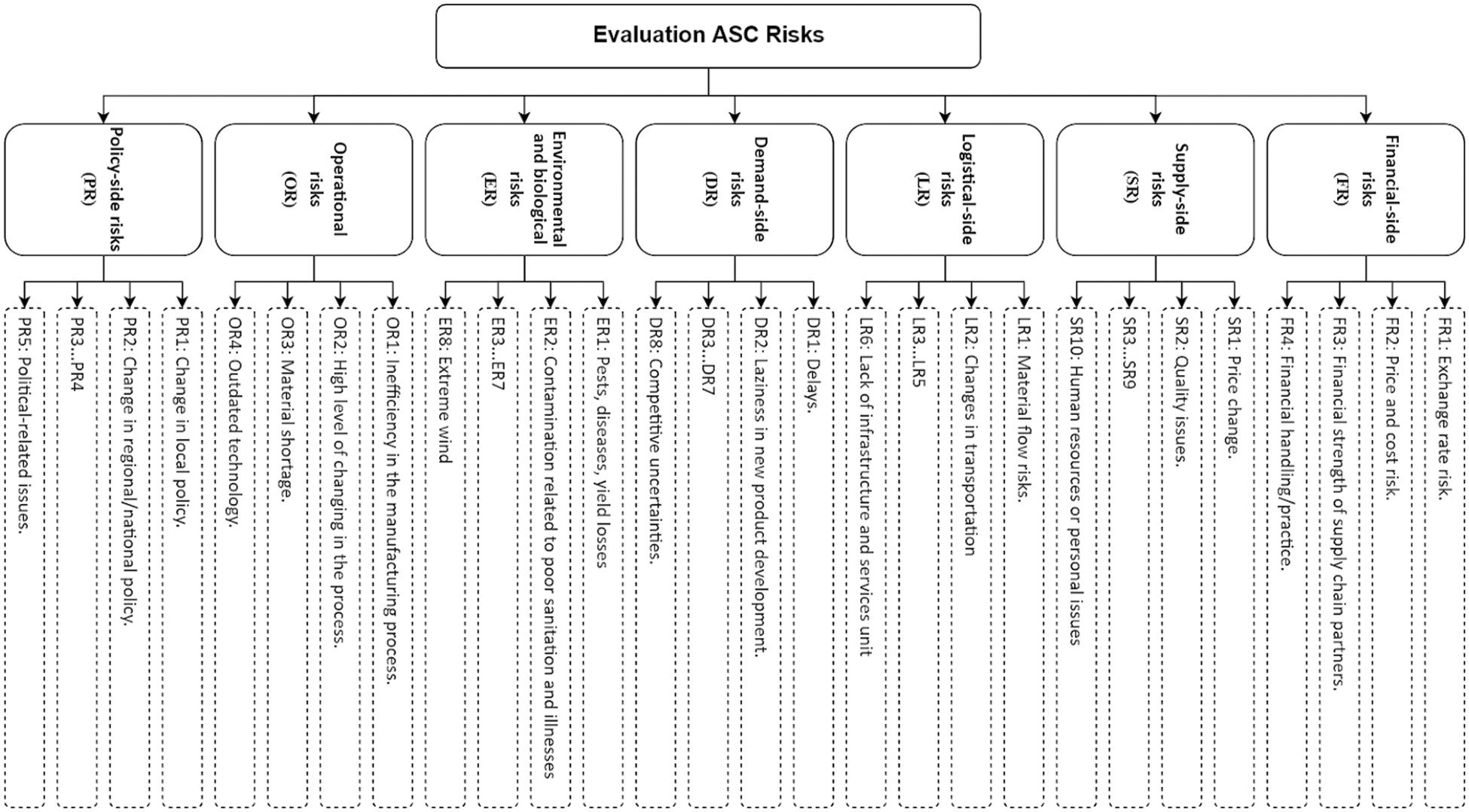
Figure 2: Hierarchy framework
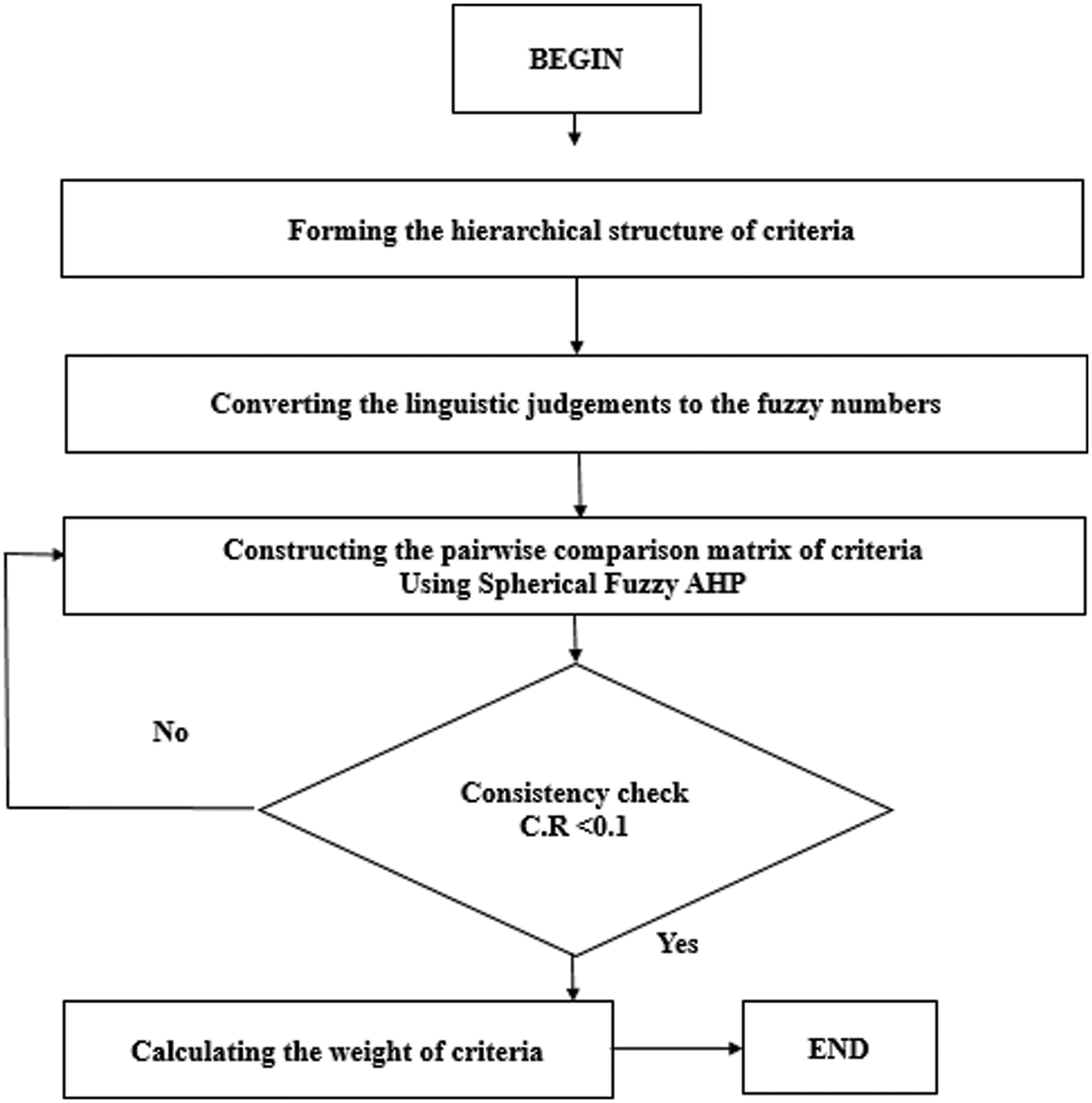
Figure 3: Proposed research framework



FR in respect to SR=SIFR in respect to SRSUMSR=0.2865.101=0.056MEANFR=0.055+0.056+0.053+0.044+0.066+0.078+0.0477=0.0568
WSV=[1.0000.2860.2060.2561.1751.0000.3113.5001.0000.7630.8032.5153.5891.7194.8661.3111.0002.0882.8313.0551.3113.9061.2460.4791.0003.3252.1411.1160.8510.3980.3530.3011.0000.1830.6491.0000.2790.3270.4675.4771.0000.5213.2150.5820.7630.8961.5401.9181.000]×[0.0560.2000.2470.1810.0620.1050.146]=[0.4351.5191.8551.3660.4460.8001.094]
CV=[0.4351.5191.8551.3660.4460.8001.094]/[0.0560.2000.2470.1810.0620.1050.146]=[7.6597.5987.4977.5157.1837.6077.472]
with seven main criteria, the λmax and CI values are calculated as follows:
λmax
with RI = 1.32 and n = 7, the CR value is calculated as:
As the consistency ratio is CR =
Thus, final spherical fuzzy weights are obtained in Tab. 6


Here, the computation process of the spherical fuzzy global weight of the FR1 criterion is presented as follows:
Supply chain vulnerability has become a significant issue for many businesses in today’s uncertain and tumultuous markets. Supply chain risk develops as supply chains get more complicated due to global sourcing and the ongoing trend toward “leaning down.” Today’s corporate challenge is to manage and minimize risk by developing more robust supply networks. Visibility between the upstream and downstream sides of the supply chain is typically inadequate since information exchange infrequently occurs and on a limited basis. As a result, supply chain agility, defined as market sensitivity, adaptability, visibility, virtual integration, and velocity, considerably mitigates risk related to financial aspects, demand, supply, and government regulations [28]. It is observed from Tab. 7 that LR has the highest weight (0.172) due to the government’s policy stopping the spread of the COVID-19 pandemic, followed by market-related risks (SR (0.162), DR (0.159), and PR (0.142). The findings suggest that when experts evaluate risks, they should emphasize logistical side risks (i.e., material flow risks, changes in transportation, incremental changes in energy costs, unreliable transportation, conflicts, labor disputes affecting transportation, and a lack of infrastructure and services units). These findings support previous research [29], which found that market risk has the greatest impact on Ghana’s agricultural industry, followed by financial, logistical, weather, biological, operational, policy, and political risk. Similarly, according to the global ranks of 47 sub-criteria, the top ten of most critical sub-criteria are LR6 > DR8 > SR9 > DR7 > LR5 > SR10 > SR7 > SR8 > PR5 > DR6. This suggests that the examination of sub-criteria belonging to LR, SR, and DR is likewise compatible with the ranking of the top three primary criteria. Additionally, it is self-evident that ER5 > FR4 > PR1 > FR2 > ER6 > OR4 > ER1 > ER3 > ER2 > ER4 > ER7 are the top ten of least important sub-criteria. This study discovered that most of the least stringent criteria were related to environmental and biological threats.

To be more explicit in Figs. 4 and 5, we also studied the ASC risks in internal and external threats because of variations in risk category weights. To manage and mitigate this issue regarding internal risks, stakeholders should pay greater attention to the highest priority of risk aspects, including OR1, FR3, LF6, DR8, and SR9. In contrast, under the category of external ASC threats, PR5 holds the highest importance. The next significant risk in this category is ER8. The risks associated with global supply chain management have created a discourse among practitioners and academics. This is evident in the business uncertainties growing in supply chain management, which threaten the entire network flow and economy [30].
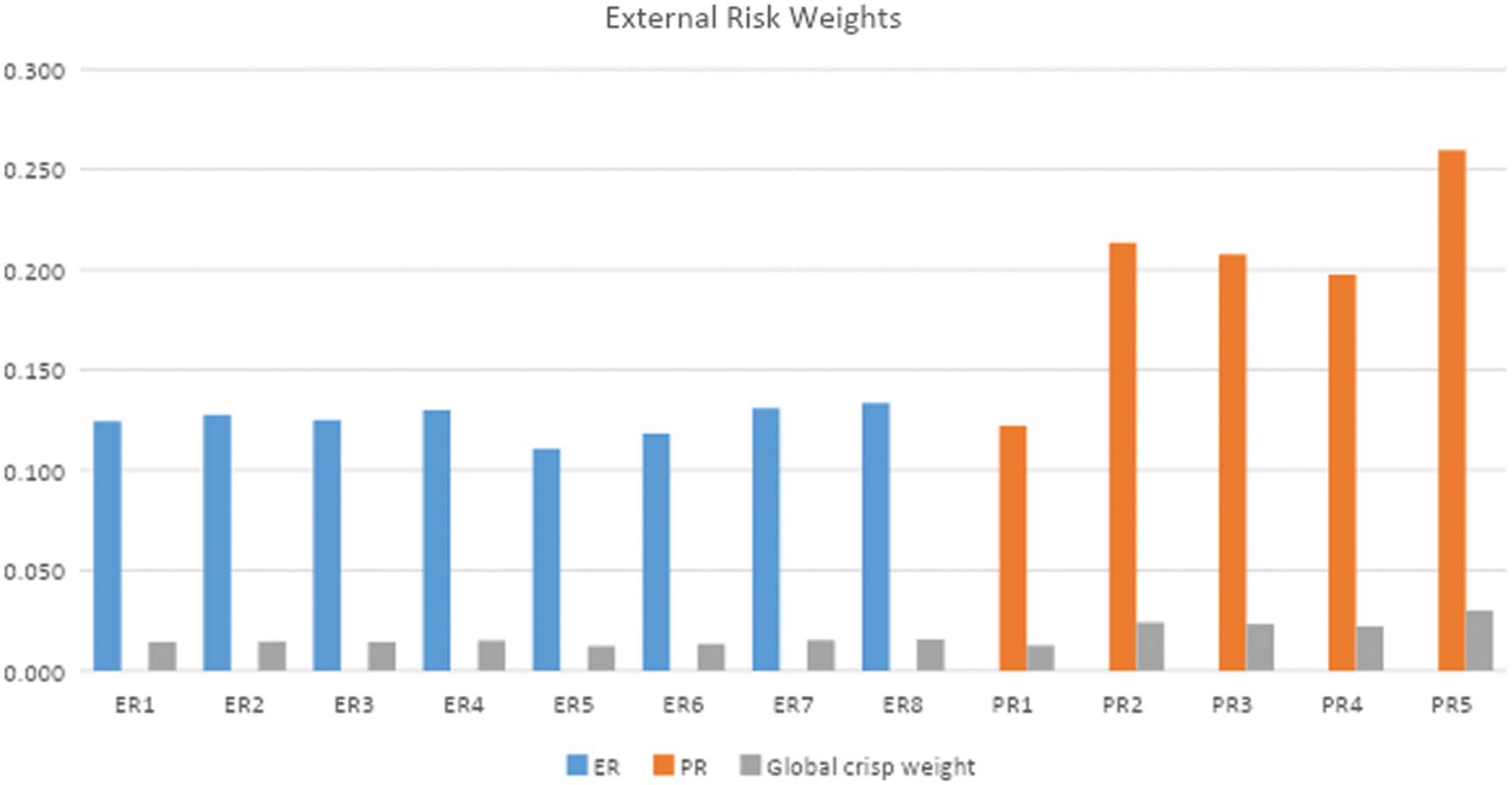
Figure 4: Results of internal risks
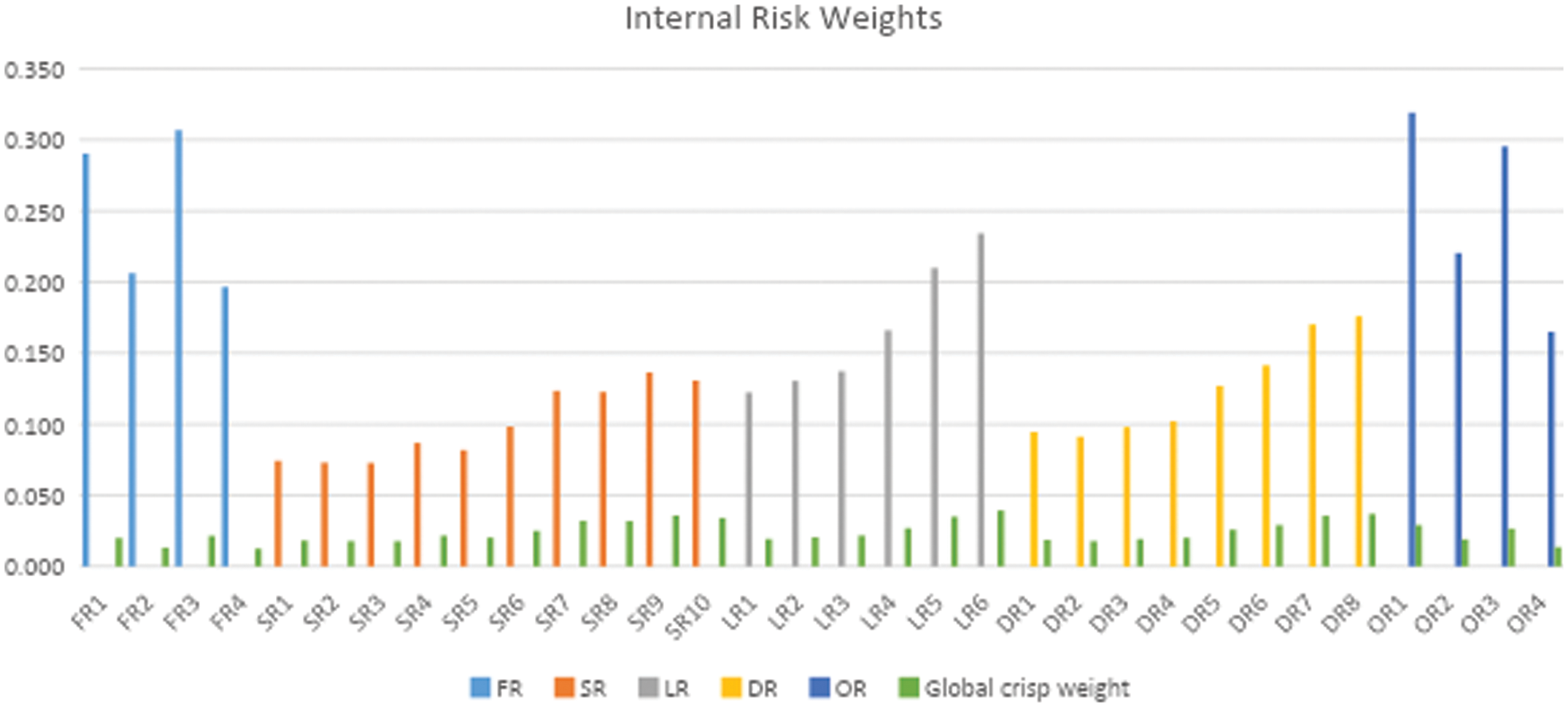
Figure 5: Results of external risks
Moreover, context is critical in supply chain risk management; for example, the nature of the risk or the strategy’s success may be influenced by the industry, country, or other factors. Additional research in under-represented environments, notably developing countries, is necessary. Likewise, the supplier perspective is underrepresented. This is crucial because suppliers can create downstream disruptions, leading to losses or even business instability, necessitating the deployment of cross-organizational solutions to supply chain risks. Thus, an extensive review is essential to gain insights from suppliers’ perspectives to assist enterprises in managing risks more effectively [31].
This research aims to quantify the severe risks posed by COVID-19 to the Vietnamese agriculture supply chain. The main contributions of this paper can be summarized as follows. First, the comprehensive development of the ASC assessment criteria employing expert responses and literature is a significant advantage of this research. Second, to the best of the authors’ knowledge, none of the existing studies presented a case study assessing the ASC risks in Vietnam under COVID-19 impacts using the proposed model of SF- AHP. The analysis will allow the decision-makers to test the observation stability. Finally, the managerial implications of the applied methodology and its analysis will provide insight to decision-makers of the agribusiness industry not only in Vietnam but also in the global market. For future studies, the proposed method in this paper can be associated with more novel factors that affect the ASC. Different techniques such as Spherical fuzzy extensions of Entropy, ANP, Delphi, and DEMATEL models could be utilized compared to MCDM models integrating Grey theory [32].
Further research could also apply the proposed method or relevant approaches to specific industries, especially those relating to the automotive manufacturing sector, to test the general validity of the results. The present study was done during the pandemic; therefore, it was practically difficult to get information from many participants. Therefore, studies should be carried out post-pandemic encompassing a larger dataset. Similarly, future studies can compare the impact of risks in developing and developed countries during the COVID-19 pandemic.
Acknowledgement: The author would like to thank the experts who contributed to the article.
Funding Statement: This work was supported in part by FPT University, Vietnam.
Conflicts of Interest: The author declares that they have no conflicts of interest to report regarding the present study.
1. R. Sharma, A. Shishodia, S. Kamble, A. Gunasekaran and A. Belhadi, “Agriculture supply chain risks and COVID-19: Mitigation strategies and implications for the practitioners,” International Journal of Logistics Research and Applications, vol. 1, no. 1, pp. 1–27, 2020. [Google Scholar]
2. R. Barichello, “The COVID-19 pandemic: Anticipating its effects on Canada’s agricultural trade,” Canadian Journal of Agricultural Economics/Revue canadienne d'agroeconomie, vol. 68, no. 2, pp. 219–224, 2020. [Google Scholar]
3. R. Siche, “What is the impact of COVID-19 disease on agriculture?,” Scientia Agropecuaria, vol. 11, no. 1, pp. 3–9, 2020. [Google Scholar]
4. S. Despoudi, U. Sivarajah and M. Dora, “Opportunities and challenges of circular agricultural supply chains,” in From Linear to Circular Food Supply Chains. Cham: Palgrave Macmillan, pp. 67–74, 2021. [Google Scholar]
5. P. H. Nguyen, J. F. Tsai, V. A. G. Kumar and Y. C. Hu, “Stock investment of agriculture companies in the Vietnam stock exchange market: An AHP integrated with GRA-TOPSIS-MOORA approaches,” The Journal of Asian Finance, Economics, and Business, vol. 7, no. 7, pp. 113–121, 2020. [Google Scholar]
6. C. Khandelwal, M. Singhal, G. Gaurav, G. S. Dangayach and M. L. Meena, “Agriculture supply chain management: A review (2010–2020),” Materials Today: Proceedings, vol. 47, pp. 3144–3153, 2021. [Google Scholar]
7. S. R. Isakson, “Food and finance: The financial transformation of agro-food supply chains,” The Journal of Peasant Studies, vol. 41, no. 5, pp. 749–775, 2014. [Google Scholar]
8. V. S. Chopra, “Supply chain management, strategy , planning & operation,” in Das summa summarum des management. Wiesbaden: Gabler, 2006. [Google Scholar]
9. J. E. Hobbs, “Food supply chains during the COVID-19 pandemic,” Canadian Journal of Agricultural Economics/Revue canadienne d'agroeconomie, vol. 68, no. 2, pp. 171–176, 2020. [Google Scholar]
10. M. Torero, “Without food, there can be no exit from the pandemic,” Nature, vol. 580, no. 7805, pp. 588–589, 2020. [Google Scholar]
11. N. Khan, “Drastic impacts of COVID-19 on food, agriculture and economy,” Pure and Applied Biology (PAB), vol. 10, no. 1, pp. 7–10, 2021. [Google Scholar]
12. D. Farnsworth, “COVID-19 policy affecting agricultural labor,” Choices, vol. 35, no. 3, pp. 1–6, 2020. [Google Scholar]
13. E. Haley, S. Caxaj, G. George, J. Hennebry, E. Martell et al., “Migrant Farmworkers face heightened vulnerabilities during COVID-19,” Journal of Agriculture, Food Systems, and Community Development, vol. 9, no. 3, pp. 1–5, 2020. [Google Scholar]
14. B. Larue, “Labor issues and COVID-19,” Canadian Journal of Agricultural Economics/Revue canadienne d'agroeconomie, vol. 68, no. 2, pp. 231–237, 2020. [Google Scholar]
15. J.-C. Kao, C.-N. Wang, N. Tinh Nguyen and V. Syed Tam Husain, “A Fuzzy MCDM model of supplier selection in supply chain management,” Intelligent Automation and Soft Computing, vol. 31, no. 3, pp. 1451–1466, 2022. [Google Scholar]
16. A. Kumar, S. K. Mangla, P. Kumar and M. Song, “Mitigate risks in perishable food supply chains: Learning from COVID-19,” Technological Forecasting and Social Change, vol. 166, no. 1, pp. 120643, 2021. [Google Scholar]
17. X. Li, Q. Wu, C. W. Holsapple and T. Goldsby, “An empirical examination of firm financial performance along dimensions of supply chain resilience,” Management Research Review, vol. 40, no. 3, pp. 254–269, 2017. [Google Scholar]
18. G. Bressanelli, M. Perona and N. Saccani, “Challenges in supply chain redesign for the circular economy: A literature review and a multiple case study,” International Journal of Production Research, vol. 57, no. 23, pp. 7395–7422, 2019. [Google Scholar]
19. G. Hailu, “Economic thoughts on COVID-19 for Canadian food processors,” Canadian Journal of Agricultural Economics/Revue canadienne d'agroeconomie, vol. 68, no. 2, pp. 163–169, 2020. [Google Scholar]
20. J. M. Tarn, D. C. Yen and M. Beaumont, “Exploring the rationales for ERP and SCM integration,” Industrial Management & Data Systems, vol. 102, no. 1, pp. 26–34, 2002. [Google Scholar]
21. G. K. C. Msuku, Z. J. Binti, I. M. Husny and M. Mehdi, “Transportation challenges in fertilizer supply chain in Malawi,” International Journal of Supply Chain Management, vol. 9, no. 1, pp. 356–365, 2020. [Google Scholar]
22. M. Yazdani, E. D. R. S. Gonzalez and P. Chatterjee, “A multi-criteria decision-making framework for agriculture supply chain risk management under a circular economy context,” Management Decision, vol. 59, no. 8, pp. 1801–1826, 2019. [Google Scholar]
23. M. Akbari, H. Memarian, E. Neamatollahi, M. Jafari Shalamzari, M. Alizadeh Noughani et al., “Prioritizing policies and strategies for desertification risk management using MCDM-DPSIR approach in northeastern Iran,” Environment Development and Sustainability, vol. 23, no. 2, pp. 2503–2523, 2021. [Google Scholar]
24. B. B. Gardas, R. D. Raut and B. Narkhede, “Evaluating critical causal factors for post-harvest losses (PHL) in the fruit and vegetables supply chain in India using the DEMATEL approach,” Journal of Cleaner Production, vol. 199, no. 1, pp. 47–61, 2018. [Google Scholar]
25. P. Nguyen, J. Tsai, T. Dang, M. Lin and H. Pham, “A hybrid spherical fuzzy MCDM approach to prioritize governmental intervention strategies against COVID-19 pandemic: A case study from Vietnam,” Mathematics, vol. 9, no. 20, pp. 2626–2654, 2021. [Google Scholar]
26. F. Kutlu Gündoğdu and C. Kahraman, “A novel spherical fuzzy analytic hierarchy process and its renewable energy application,” Soft Computing, vol. 24, no. 6, pp. 4607–4621, 2020. [Google Scholar]
27. P. H. Nguyen, J. F. Tsai, T. T. Dang, M. H. Lin, H. A. Pham et al., “A hybrid spherical fuzzy MCDM approach to prioritize governmental intervention strategies against the COVID-19 pandemic: A case study from Vietnam,” Mathematics, vol. 9, no. 20, pp. 1–28, 2021. [Google Scholar]
28. M. Christopher and H. Peck, “Building the resilient supply chain,” Journal of Operations Management, vol. 16, no. 2–3, pp. 241–255, 1998. [Google Scholar]
29. E. Evelyn and N. Edmondyeboah, “Ranking agricultural supply chain risk in Ghana: An AHP approach,” International Journal of Economics, Commerce and Management, vol. 3, no. 2, pp. 1–12, 2015. [Google Scholar]
30. A. Gurtu and J. Johny, “Supply chain risk management: Literature review,” Risks, vol. 9, no. 1, pp. 1–16, 2021. [Google Scholar]
31. Y. Fan and M. Stevenson, “A review of supply chain risk management: Definition, theory, and research agenda,” International Journal of Physical Distribution & Logistics Management, vol. 48, no. 3, pp. 205–230, 2018. [Google Scholar]
32. C. N. Wang, T. T. Dang, N. A. T. Nguyen and J. W. Wang, “A combined Data Envelopment Analysis (DEA) and Grey based multiple criteria decision making (G-MCDM) for solar PV power plants site selection: A case study in Vietnam,” Energy Reports, vol. 8, no. 4, pp. 1124–1142, 2022. [Google Scholar]
 | This work is licensed under a Creative Commons Attribution 4.0 International License, which permits unrestricted use, distribution, and reproduction in any medium, provided the original work is properly cited. |